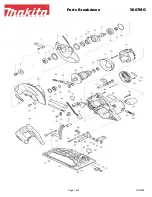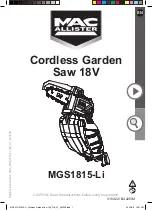
13
Blade Alignment Adjustment
(Blade Parallel to Miter Slot)
WARNING:
Cut Hazard. Check the blade at 0
˚
and 45
˚
to make sure blade does
not hit the throat plate, causing personal injury.
If the blade appears to be out of alignment with the miter slot on the table top, it will
require calibration for alignment. To realign the blade and miter slot, use the following
procedure:
1. Locate the black hex locator screws (OO) that hold up the trunnion to the
bottom of the table in the rear of the saw.
2. Loosen both screws and align the blade with the miter slot. Be sure to measure
between the miter slot and the back and front of the blade to ensure parallelism.
3. Snugly tighten the screws to secure the trunnion and blade assembly to the table
at the parallel position.
Fence Alignment Adjustment (Fig. 4, 5)
(Blade Parallel to Fence)
If you experience fence alignment problems and want to correct an out of parallel
between the fence and the blade, be sure to check the alignment of the blade to
the miter slot first. After confirming that those elements are aligned, proceed with
alignment of the blade to the fence using the following procedure:
1. Unlock the rail lock lever (W) and locate the two fence locator screws (AA) that
support the fence on the front and rear rails.
2. Loosen the rear locator screw and adjust the position of the fence in the
groove on the fence until it sets the fence face parallel to the blade. Make sure
you measure from the fence face to the front and back of the blade to ensure
alignment.
3. Tighten the locator screw and repeat on the left side of the blade.
4. Check rip scale adjustment.
Bevel Stop and Pointer Adjustment
(Calibrating Bevel Scale)
Calibrating the bevel system on the saw may require two separate steps, one for the
bevel scale and another for the bevel pointer. The scale should always be checked
first followed by adjustments to the red pointer.
Bevel Lock Adjustment (Fig. 20)
The bevel lock lever (J) may need adjustment to maintain lock force.
To do this, put the lock lever in the locked position. Use a crosshead screwdriver to
remove the screw (PP) holding the lock lever in place (Fig. 20). Remove the lock lever
from the locking bolt and place lock lever in the desired position. Insert the screw
(PP) and tighten securely.
FIG. 20
J
J
PP
PART A – ADJUSTING THE BEVEL SCALE SYSTEM (FIG. 21, 22)
1. Remove the Blade guard assembly from the saw and raise the blade all the way
up in the table.
2. Unlock the bevel lock lever (J) and loosen the bevel stop screw (QQ).
3. Place a square against the table and blade.
NOTE:
Be sure to place the square between the teeth on the blade to ensure an
accurate measurement.
4. Adjust the bevel angle until the blade is flat against the square. Lock the bevel
lock lever (J).
5. Move the bevel stop cam (RR) until it firmly contacts the trunnion casting.
Tighten the bevel stop screw.
6. Repeat procedure at 45
˚
using a triangle or speed square.














































